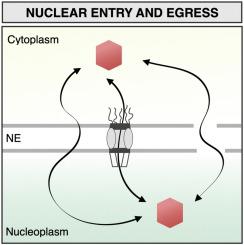The International Journal of Biochemistry & Cell Biology ( IF 3.4 ) Pub Date : 2020-11-04 , DOI: 10.1016/j.biocel.2020.105875 Freya Molenberghs 1 , Johannes J Bogers 1 , Winnok H De Vos 1

|
Viruses are obligatory intracellular parasites. For their efficient replication, many require access to the nuclear interior. Yet, only few viral particles are small enough to passively diffuse through the nuclear pore complexes, calling for alternative strategies to bypass the nuclear envelope barrier. Some viruses will await mitotic nuclear envelope breakdown to gain access, whereas others will exploit more active means, for instance by hijacking nuclear pore transport or by directly targeting constituents of the nuclear envelope so as to remodel and temporarily perturb its integrity. After replication, newly produced viral DNA complexes need to cross the same barrier to exit the nucleus and enter the cytoplasm, where the final stages of virion maturation take place. There are also different flavours to the feat of nuclear egress that vary in delicacy and intensity. In this review, we define the major entry and egress strategies that are exploited by different viruses and describe the molecular details thereof. Ultimately, a deeper understanding of these pathways may help identifying molecular targets for blocking viral reproduction or spreading.
中文翻译:

不再受限:核进出的病毒机制
病毒是必须的细胞内寄生虫。为了有效复制,许多需要进入核内部。然而,只有少数病毒颗粒小到可以被动扩散通过核孔复合物,因此需要替代策略来绕过核膜屏障。一些病毒将等待有丝分裂的核膜破裂才能进入,而另一些病毒将利用更积极的手段,例如通过劫持核孔运输或直接针对核膜的成分来重塑和暂时扰乱其完整性。复制后,新产生的病毒 DNA 复合物需要穿过相同的屏障才能离开细胞核并进入细胞质,在那里进行病毒体成熟的最后阶段。核出口的壮举也有不同的风味,其精致度和强度各不相同。在这篇综述中,我们定义了不同病毒利用的主要入口和出口策略,并描述了其分子细节。最终,更深入地了解这些途径可能有助于确定阻止病毒繁殖或传播的分子靶标。











































 京公网安备 11010802027423号
京公网安备 11010802027423号